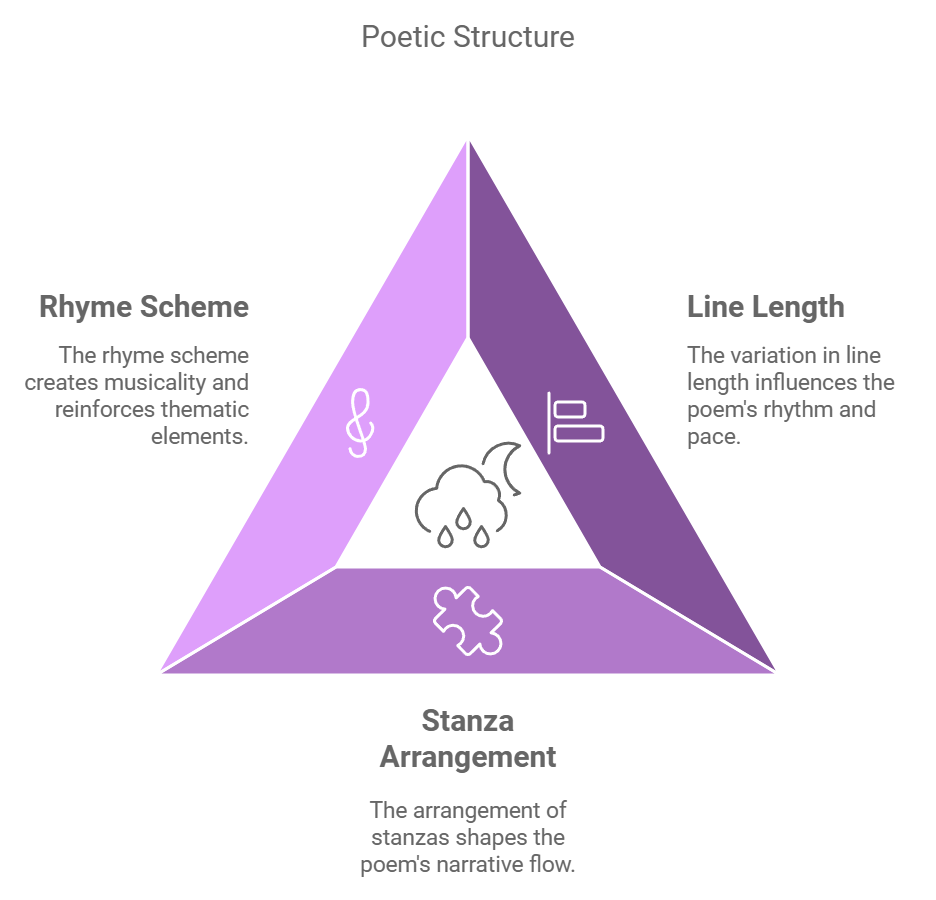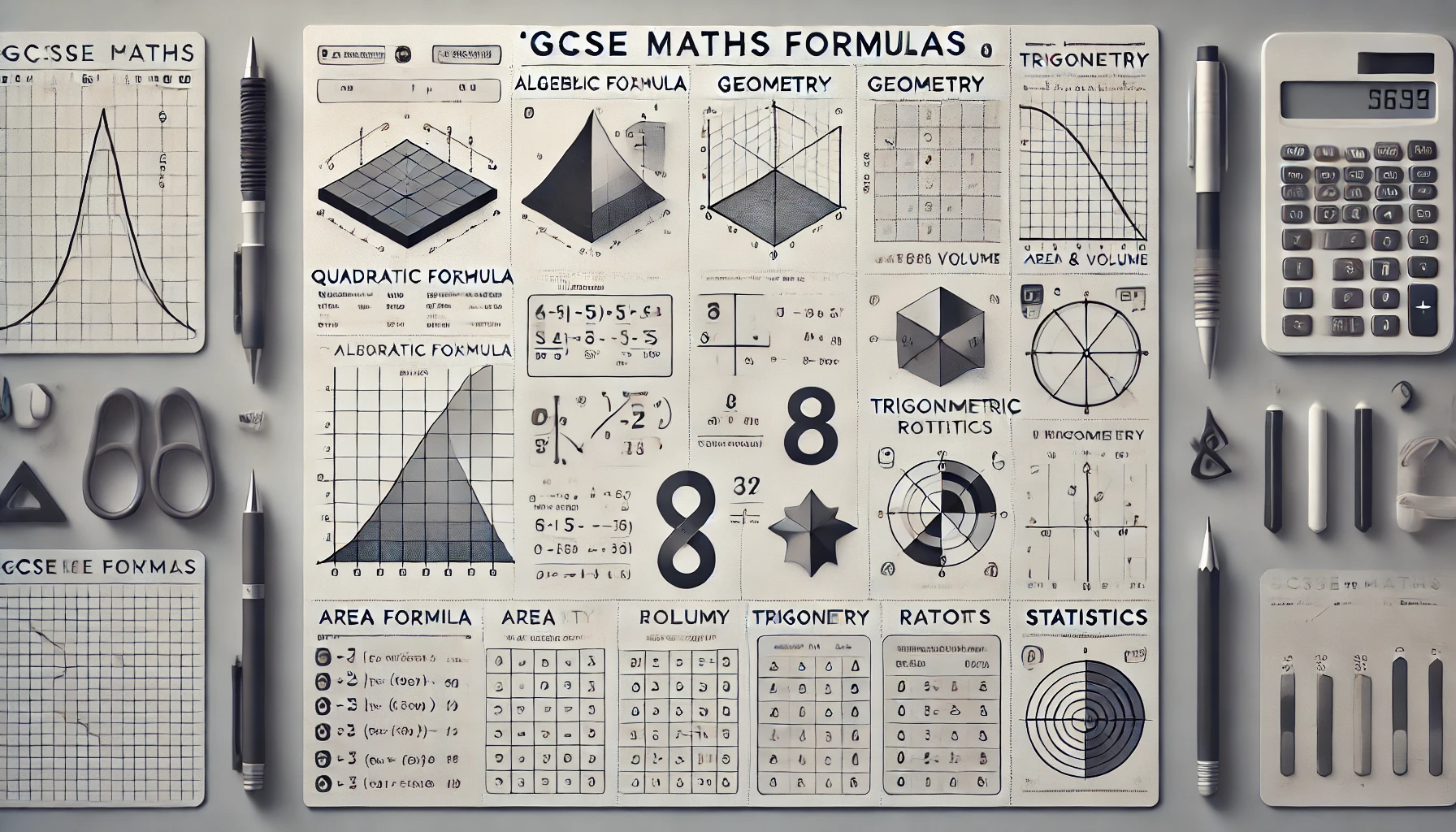Guide to Poem Structure for GCSE English Literature
Robert frost once said: “Poetry is when an emotion has found its thought and the thought has found words.” Indeed, Poetry is a unique literary form that uses language, rhythm, and structure to express emotions, ideas, and stories in powerful, compact ways. Understanding poetry can be deeply rewarding, especially for GCSE English Literature students, where poetry analysis plays a significant role. Familiarity with a poem structure allows students to interpret its meaning, themes, and emotional impact more effectively.
In this guide, we’ll explore what structure means in poetry, how it differs from form, and the types of structure commonly found in poems, providing a solid foundation for GCSE students. So, let’s explore together everything about poem structure.
What is a Definition of a Poem Structure?
Poem Structure refers to the overall framework or organization of a poem, including how it’s arranged on the page, its line breaks, stanza divisions, rhyme scheme, rhythm, and any other elements that contribute to its shape and flow.
Poem structure gives a poem its shape and affects how we read and interpret its meaning. Structural choices can influence a poem’s pacing, mood, and emphasis on certain ideas, making it essential for readers to understand and analyse a poem’s structure to fully appreciate its depth.
What is Form in Poetry?
Form in poetry refers to the specific type or pattern that a poem follows, often determined by traditional conventions. Forms include sonnets, haikus, ballads, and odes, each with its own set of rules for line length, rhyme scheme, and subject matter.
What Is A Difference Between Poem Structure And Form?
While form refers to a poem’s overall pattern or type (e.g., a sonnet or haiku), poem structure refers to how a poem is organised within that form. For example, a sonnet’s form follows a specific 14-line structure with a rhyme scheme, but its internal structure might vary depending on the writer’s use of line breaks, enjambment, and stanza divisions to enhance meaning. Structure is the internal arrangement within a chosen form.

Key Elements of Poem Structure
Let’s look at some common structural elements in poetry, with examples to show how each one shapes the poem:
Meter
Meter is the rhythmic pattern of stressed and unstressed syllables in a line. It adds musicality and flow, setting the poem’s pace and mood. Common meters include iambic pentameter (five pairs of unstressed-stressed syllables) and trochaic tetrameter (four pairs of stressed-unstressed syllables).
- Example: Shakespeare often used iambic pentameter, as in Sonnet 18: “Shall I compare thee to a summer’s day?”
Meter adds rhythm and structure, guiding how the poem is read aloud and enhancing its emotional quality. Regular meter feels balanced, while irregular meter can create surprise or tension.
Rhyme Scheme
A rhyme scheme is the pattern of rhyming words at the end of lines, marked by letters (e.g., ABAB or AABB). It brings cohesion to a poem and often creates rhythm and memorability.
- Example: A Shakespearean sonnet follows the rhyme scheme ABABCDCDEFEFGG.
Rhyme schemes add unity and musicality, making lines flow together. A consistent rhyme scheme gives structure, while an unusual scheme may create suspense or surprise.
Verse
Verse in poem structure refers to a single line of poetry. Poems are usually divided into verses (single lines) or verses in stanzas (groups of lines), which can shape how the poem’s themes unfold.
- Example: Blank verse, which uses unrhymed iambic pentameter, appears in much of Shakespeare’s work, adding a natural rhythm without rhyme.
Verse gives poetry a defined structure. Blank verse, for example, creates a formal yet flowing feel, whereas free verse allows for more spontaneity and variation.
Stanzas
A stanza is a group of lines in a poem, functioning like paragraphs in prose. Common stanza forms include quatrains (four lines), tercets (three lines), and couplets (two lines).
- Example: In Robert Frost’s Stopping by Woods on a Snowy Evening, each stanza consists of four lines (quatrain).
Stanzas organise thoughts, emphasise ideas, and create pauses. Different stanza structures affect the rhythm and pacing of a poem, making it feel structured or spontaneous.
Enjambment and Caesura in Poem Structure
Enjambment is when a line breaks without punctuation, continuing onto the next line, while caesura is a pause within a line.
- Example: In John Donne’s The Good-Morrow, enjambment stretches ideas across lines, adding flow and continuity.
Enjambment speeds up the reading pace and creates suspense. Caesura, on the other hand, introduces pauses, encouraging reflection and adding emphasis to certain words or phrases.
Refrain
A refrain is a repeated line or group of lines in a poem, often at the end of stanzas. It reinforces the poem’s themes and rhythm.
- Example: In Poe’s The Raven, the word “Nevermore” is a haunting refrain.
Refrains make poems memorable and add structure by repeating key phrases or lines. They emphasise the main message, especially in lyrical or narrative poetry.
Line Length and Breaks
Line length and where a poet chooses to break lines influence pacing and emphasis. Long lines can feel flowing or meditative, while short lines create tension and speed.
- Example: Whitman’s Leaves of Grass has long lines that feel expansive and free, matching the theme of nature and freedom.
Line length shapes the poem’s rhythm. Long lines feel relaxed, while shorter lines add urgency and intensity.
Volta
The volta, or “turn,” is a shift in tone, mood, or argument, commonly found in sonnets. It introduces a new perspective, sometimes resolving or complicating the poem’s central theme.
- Example: In Petrarchan sonnets, the volta typically occurs between the eighth and ninth lines, bringing a change in focus.
The volta provides a moment of reflection or transformation, adding depth to the poem’s message and guiding the reader’s emotional response.
Why It’s Important To Understand Poem Structure?
Understanding a poem’s structure helps GCSE students appreciate the poet’s craft and analyse how language, rhythm, and form work together to create meaning. Moreover, it enables students to discuss poetry more confidently, preparing them for exam analysis and, ultimately, enhancing their love for literature. For instance, from meter to rhyme, each element adds something unique, allowing poets to express complex emotions and ideas in a few lines.

Poetry Styles with Unique Structures
Certain poetry styles, in particular, are known for their distinctive structures, which follow specific rules of rhyme, syllable count, or line pattern. By understanding these unique forms, students can better recognise how poets use structure to convey meaning, rhythm, and emotion. In the following sections, we’ll delve into three popular forms—Haiku, Sonnet, and Limerick—each bringing a unique approach to structure.
What Is Haiku?
The haiku is a traditional Japanese form of poetry that focuses on simplicity and nature, often capturing a fleeting moment or emotion. Haikus have a compact structure, consisting of just three lines with a strict syllable count:
- Structure: The first line has 5 syllables, the second line has 7 syllables, and the third line has 5 syllables again, following a 5-7-5 syllable pattern.
- Themes: Haikus traditionally centre around nature, seasons, or simple observations about life, aiming to capture the essence of a moment. While haikus are short, they’re often rich with imagery and metaphor, encouraging readers to pause and reflect.
For Example:
An old silent pond…
A frog jumps into the pond—
Splash! Silence again.
In this famous haiku by Matsuo Basho, the poem captures a single moment in nature, using sensory details to evoke an image and a feeling of stillness.
The haiku’s strict poem structure forces the poet to be concise, focusing on the essence of a moment. This minimalism encourages readers to interpret deeper meanings and connect with nature, making haikus both simple and profound.
What Is Sonnet?
The sonnet is a 14-line poem that originated in Italy and became widely popular in English literature, especially through the works of William Shakespeare. Sonnets are known for their expressive, romantic themes, often exploring love, beauty, or philosophical questions. The sonnet form follows specific rhyme schemes and is divided into two main styles:
1. Petrarchan Sonnet
- Structure: A Petrarchan (or Italian) sonnet has an octave (eight lines) followed by a sestet (six lines).
- Rhyme Scheme: The octave typically follows an ABBAABBA rhyme scheme, while the sestet can vary (e.g., CDECDE or CDCDCD).
- Volta: The Petrarchan sonnet often includes a volta or “turn” between the octave and sestet, signalling a shift in tone or perspective. This change often introduces a solution to a problem or a new angle on the theme.
For example: John Milton’s Sonnet XIX explores his internal conflict over his blindness:
When I consider how my light is spent,
Ere half my days, in this dark world and wide,
And that one talent which is death to hide
Lodged with me useless, though my soul more bent…
2. Shakespearean Sonnet
- Structure: The Shakespearean (or English) sonnet is divided into three quatrains (four-line stanzas) and ends with a rhyming couplet (two lines).
- Rhyme Scheme: The rhyme scheme for a Shakespearean sonnet is ABABCDCDEFEFGG.
- Volta: In Shakespearean sonnets, the volta often appears in the final rhyming couplet, offering a resolution or a profound insight.
Example: Shakespeare’s Sonnet 18, “Shall I compare thee to a summer’s day?” explores the theme of eternal beauty:
Shall I compare thee to a summer’s day?
Thou art more lovely and more temperate…
So long as men can breathe or eyes can see,
So long lives this, and this gives life to thee.
Sonnets combine strict structure with flexibility, allowing poets to develop a theme in multiple layers. The use of rhyme, meter, and the volta creates a sense of musicality and emotional depth, perfect for exploring complex ideas or feelings.
What Is Limerick?
The limerick, in particular, is a lighthearted, often humorous five-line poem known for its catchy rhythm and punchy rhymes. Moreover, limericks have a unique and recognisable structure that gives them a playful, sometimes even mischievous, tone. Consequently, this form is often used for storytelling or delivering a witty punchline..
- Structure: Limericks follow a five-line structure with a distinct rhythm and rhyme scheme.
- Lines 1, 2, and 5 rhyme with each other and are longer, typically following an AABBA rhyme scheme.
- Lines 3 and 4 are shorter and also rhyme with each other.
- Rhythm: Limericks have a bouncy rhythm, usually in anapestic meter (two short syllables followed by a longer one) or amphibrachic meter (one unstressed syllable, one stressed, and another unstressed).
- Themes: Often humorous or nonsensical, limericks tell short, amusing stories or deliver clever observations. They are commonly associated with comic or whimsical content.
Example:
There once was a man from Peru
Who dreamed he was eating his shoe.
He awoke with a fright
In the middle of the night
To find that his dream had come true.
The limerick’s rhythmic and rhyming structure makes it memorable and entertaining, allowing for playful storytelling or punchlines. Its simplicity and catchy rhythm make limericks accessible and fun, appealing to readers of all ages.
Why Does Understanding Poem Styles Matters?
Each of these poetry styles—Haiku, Sonnet, and Limerick—has a distinct structure that shapes its tone, pacing, and emotional impact. Understanding these forms enables students to better appreciate the poet’s choices and how structure influences meaning.
Whether it’s the minimalistic beauty of a haiku, the depth of a sonnet, or the playful nature of a limerick, recognising these structures helps students analyse poetry with greater insight and enjoyment.

Can Poems Have Different Forms and Structure?
Yes, a poem can incorporate multiple forms or structures, blending different elements to create unique effects. While traditional poems often stick to one form, many modern and contemporary poets experiment with structure to add layers of meaning, break conventions, or create specific emotional responses. Here’s how poets might combine multiple forms or structures in a single poem:
Blending Forms
- A poet might combine elements of a sonnet and free verse in a single poem, using the sonnet’s 14-line structure and volta but ignoring the strict rhyme and meter requirements.
- Some poets use the haiku form within longer poems, inserting haiku-like stanzas (following a 5-7-5 syllable pattern) to create moments of reflection or pause amid other structures.
Using Multiple Structures
- A poem may shift from rhymed quatrains to free verse in different sections, using rhyme to create rhythm and cohesion in one part, then breaking it to signify a shift in tone or subject.
- Poets might start with regular stanza lengths and a clear meter, then move to irregular stanzas and line lengths, reflecting changes in the poem’s theme, emotion, or narrative focus.
Integrating Refrains and Voltas
- Even outside sonnets, poets sometimes use voltas (shifts in tone or perspective) to introduce contrasting ideas or emotions. A poem could incorporate multiple voltas to guide readers through evolving themes.
- Refrains are often paired with other structures, such as free verse or blank verse, to add rhythm or reinforce central themes.
Examples in Poetry
- T.S. Eliot’s The Waste Land: This famous poem mixes traditional forms, such as sonnets, with free verse, refrains, and varying structures across its sections.
- Dylan Thomas’s Do Not Go Gentle into That Good Night: This villanelle uses a strict form but blends it with repetitive refrains to enhance the emotional impact.
Combining forms and structures allows poets to experiment creatively and tailor the poem to their message, tone, and themes, giving them freedom to defy convention and engage readers on multiple levels. For GCSE students, recognising these structural shifts can add depth to their analysis, helping them appreciate the poet’s intentional choices.
Resources For Learning More About Poem Structure
“Poetry is not only dream and vision; it is the skeleton architecture of our lives.” — Audre Lorde. Learning poetry enriches language skills, deepens empathy, and connects us to universal human experiences. To ease your learning process, here are some excellent poetry resources to help you prepare for GCSE and A-Level English Literature:
BBC Bitesize
- BBC Bitesize offers comprehensive study guides on poetry, covering analysis, key themes, language techniques, and practice questions. It Includes interactive quizzes, annotated poems, and videos on poetry analysis.
Poetry Foundation
- Poetry Foundation’s extensive library includes classic and contemporary poems, poet biographies, and analysis tools. Students can search by theme, era, or form and explore resources tailored to GCSE-level poems.
Poetry Archive
- The Poetry Archive hosts recordings of poets reading their work, offering insights into tone, rhythm, and emotion. Webpage Includes listening guides, a glossary, and featured poems often found in GCSE syllabuses.
LitCharts
- LitCharts provides detailed poem summaries, themes, symbols, and analysis tailored for English Literature students. It offers interactive PDFs, teacher resources, and side-by-side translations for complex poems.
YouTube – GCSE Poetry Analysis Channels
- Many YouTube channels, such as Mr. Bruff, Stacey Reay, and The English Teacher, provide poem breakdowns, theme explanations, and analysis tips. Video format helps with auditory learning and offers step-by-step analysis.
These resources can provide valuable support for students, helping them better understand, analyse, and appreciate poetry as they prepare for their exams.
Conclusion
Mastering poem structure is, indeed, crucial for students aiming to excel in GCSE and A-Level English Literature. Furthermore, understanding elements like stanza organisation, rhyme schemes, and meter allows students to interpret poetry on a deeper level, connecting form with meaning and enhancing their analytical skills. Structure, after all, isn’t just about rules; it’s the backbone of a poem that shapes its tone, pace, and emotional impact.
For those looking to build confidence and refine their skills, online English language tutors can, moreover, provide valuable, personalised guidance, helping students navigate complex structures and uncover each poem’s unique artistry. With this focused support, students can approach poetry analysis with both clarity and success.








